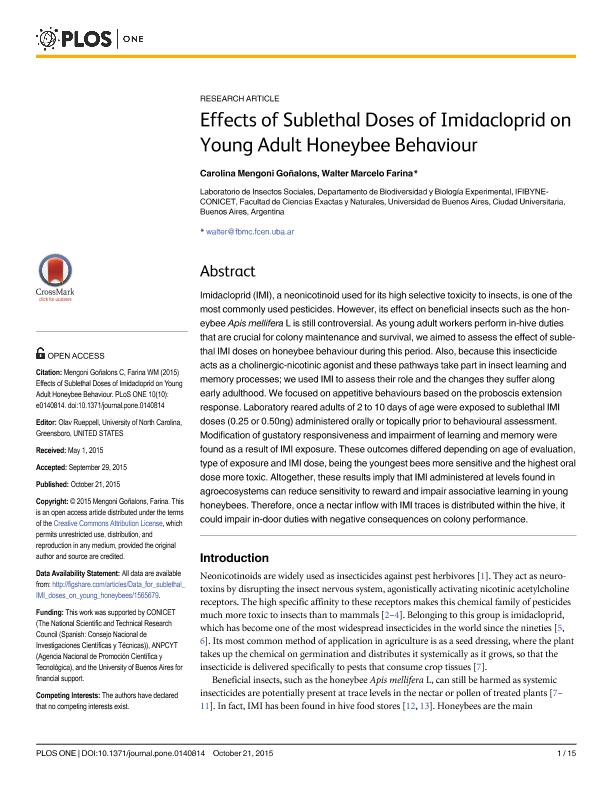Mostrar el registro sencillo del ítem
dc.contributor.author
Mengoni Goñalons, Carolina

dc.contributor.author
Farina, Walter Marcelo

dc.date.available
2017-07-11T15:40:47Z
dc.date.issued
2015-10
dc.identifier.citation
Mengoni Goñalons, Carolina; Farina, Walter Marcelo; Effects of Sublethal Doses of Imidacloprid on Young Adult Honeybee Behaviour; Public Library of Science; Plos One; 10; 10; 10-2015; 1-15; e0140814
dc.identifier.issn
1932-6203
dc.identifier.uri
http://hdl.handle.net/11336/20109
dc.description.abstract
Imidacloprid (IMI), a neonicotinoid used for its high selective toxicity to insects, is one of the most commonly used pesticides. However, its effect on beneficial insects such as the honeybee Apis mellifera L is still controversial. As young adult workers perform in-hive duties that are crucial for colony maintenance and survival, we aimed to assess the effect of sublethal IMI doses on honeybee behaviour during this period. Also, because this insecticide acts as a cholinergic-nicotinic agonist and these pathways take part in insect learning and memory processes; we used IMI to assess their role and the changes they suffer along early adulthood. We focused on appetitive behaviours based on the proboscis extension response. Laboratory reared adults of 2 to 10 days of age were exposed to sublethal IMI doses (0.25 or 0.50ng) administered orally or topically prior to behavioural assessment. Modification of gustatory responsiveness and impairment of learning and memory were found as a result of IMI exposure. These outcomes differed depending on age of evaluation, type of exposure and IMI dose, being the youngest bees more sensitive and the highest oral dose more toxic. Altogether, these results imply that IMI administered at levels found in agroecosystems can reduce sensitivity to reward and impair associative learning in young honeybees. Therefore, once a nectar inflow with IMI traces is distributed within the hive, it could impair in-door duties with negative consequences on colony performance.
dc.format
application/pdf
dc.language.iso
eng
dc.publisher
Public Library of Science

dc.rights
info:eu-repo/semantics/openAccess
dc.rights.uri
https://creativecommons.org/licenses/by-nc-sa/2.5/ar/
dc.subject
Honeybee
dc.subject
Imidacloprid
dc.subject
Learning And Memory
dc.subject
Sucrose Sensitivity
dc.subject.classification
Zoología, Ornitología, Entomología, Etología

dc.subject.classification
Ciencias Biológicas

dc.subject.classification
CIENCIAS NATURALES Y EXACTAS

dc.title
Effects of Sublethal Doses of Imidacloprid on Young Adult Honeybee Behaviour
dc.type
info:eu-repo/semantics/article
dc.type
info:ar-repo/semantics/artículo
dc.type
info:eu-repo/semantics/publishedVersion
dc.date.updated
2017-07-11T13:25:58Z
dc.journal.volume
10
dc.journal.number
10
dc.journal.pagination
1-15; e0140814
dc.journal.pais
Estados Unidos

dc.journal.ciudad
San Francisco
dc.description.fil
Fil: Mengoni Goñalons, Carolina. Consejo Nacional de Investigaciones Científicas y Técnicas. Oficina de Coordinación Administrativa Ciudad Universitaria. Instituto de Fisiología, Biología Molecular y Neurociencias. Universidad de Buenos Aires. Facultad de Ciencias Exactas y Naturales. Instituto de Fisiología, Biología Molecular y Neurociencias; Argentina
dc.description.fil
Fil: Farina, Walter Marcelo. Consejo Nacional de Investigaciones Científicas y Técnicas. Oficina de Coordinación Administrativa Ciudad Universitaria. Instituto de Fisiología, Biología Molecular y Neurociencias. Universidad de Buenos Aires. Facultad de Ciencias Exactas y Naturales. Instituto de Fisiología, Biología Molecular y Neurociencias; Argentina
dc.journal.title
Plos One

dc.relation.alternativeid
info:eu-repo/semantics/altIdentifier/doi/http://dx.doi.org/10.1371/journal.pone.0140814
dc.relation.alternativeid
info:eu-repo/semantics/altIdentifier/url/http://journals.plos.org/plosone/article?id=10.1371/journal.pone.0140814
Archivos asociados
